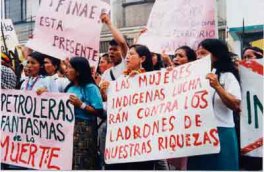
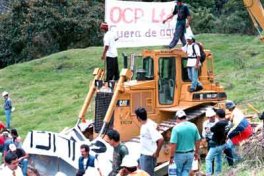


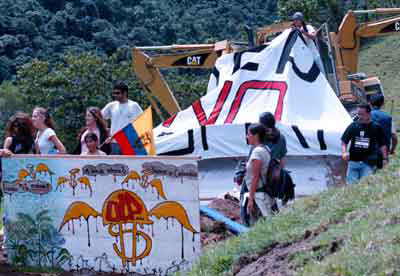 Oleoducto de Crudos Pesados (crude oil pipeline), due for completion in June 2003, will transport heavy crude from the Ecuador's Amazon rainforest region to the Pacific Coast, placing fragile ecosystems and dozens of indigenous communities along the 300-mile route in jeopardy.
Oleoducto de Crudos Pesados (crude oil pipeline), due for completion in June 2003, will transport heavy crude from the Ecuador's Amazon rainforest region to the Pacific Coast, placing fragile ecosystems and dozens of indigenous communities along the 300-mile route in jeopardy.
The pipeline is being forced through by the IMF who wish to see a reduction in Ecuador's debt, currently running at around $16 billion. Doubling the country's oil output is the IMF prescription for debt reduction, plus privatizing the country's oil facilities and infrastructure.
OCP, will be the second oil pipeline running from the Amazon to the Pacific. There is not enough oil for two pipelines, more drilling in the sensitive rainforests will follow.
The pipeline runs through sensitive environmental areas and crosses extremely rugged terrain. The experience of the existing Sote pipeline,constructed by Texaco in the 1970s, is that OCP will be an environmental and human rights disaster.
A report by Robert Goodland, former head of the World Bank Environment Department has slammed OCP as an environmental disaster and for non-compliance with World Bank guidelines. Robert Goodland, a tropical ecologist, played a lead role in producing the World Bank Social and Environmental Safeguard Policies, namely Environmental Assessment, Natural Habitats, Indigenous Peoples, and Cultural Property Policies.
Moody's gave OCP the credit rating for junk bonds, it has since removed all credit ratings from the project.
Who is behind OCP?
IMF: The International Monetary Fund’s endorsement of oil and gas expansion as a means of servicing external debt has pushed the Ecuadorian government to try to meet payments on its huge $16 billion debt through a massive oil development program in the Amazon. With future credit agreements for Ecuador in doubt, IMF is insisting that 80% of government takings from increased oil output stemming from the OCP be directed towards debt repayment.
Big Oil: The OCP Consortium includes EnCana (Canada, 31.4%), Repsol-YPF (Spain, 25.6%), Pecom Energia (Argentina, 15%), Occidental Petroleum (U.S., 12.2%), ENI-AGIP (Italy, 7.5%), Techint (Argentina, 4.1%), and Perenco (UK, 4.0%). Techint – a company with an appalling environmental track record - is building the pipeline with a carelessness that even resulted in a temporarily suspension of the project’s environmental license by the Ecuadorian government.
Financiers: The German bank Westdeutsche Landesbank (WestLB) is in the process of distributing a $900 million syndicated loan to finance the OCP. Germany’s leading environmental organizations have attacked WestLB, which is 42% controlled by the German federal state of North Rhine Westphalia (NWR). The Italian Green Party has denounced the involvement of the Italian Banca Nazionale del Lavoro in the loan. Citibank and JP Morgan Chase have also come under fire for their financial role in the project.
Government: During 30 years of oil dependency, poverty has increased in Ecuador. Yet, the recently ousted conservative government broadcast the myth of the OCP as an economic panacea for the nation and met OCP opponents with increasingly draconian repression. With the collusion of the OCP Consortium, the security forces meted out bullets, tear gas and beatings to peaceful demonstrators resulting in deaths, injuries and many arrests.
US Markets: Ecuador's oil exports are primarily destined for consumption in the United States, primarily California. US reliance on oil - the main fossil fuel responsible for climate change – is accelerating the destruction of the Amazon heartlands.
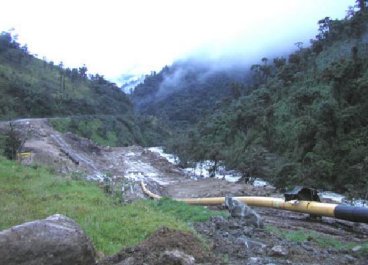 The pipeline route chosen by the OCP Consortium traverses seven national parks and protected areas, including a World Bank Global Environment Facility biodiversity reserve. Inevitable ruptures in the OCP will cause ecological disaster by spilling more oil into forest ecosystems than the existing SOTE oil pipeline, which has been ripped apart countless times by landslides, earthquakes, volcanic eruptions and insurgent bombings.
The pipeline route chosen by the OCP Consortium traverses seven national parks and protected areas, including a World Bank Global Environment Facility biodiversity reserve. Inevitable ruptures in the OCP will cause ecological disaster by spilling more oil into forest ecosystems than the existing SOTE oil pipeline, which has been ripped apart countless times by landslides, earthquakes, volcanic eruptions and insurgent bombings.
Sote has had at least 68 oil spills, releasing millions of gallons of crude oil into the environment, with the resultant destruction of 2.5 million acres of Amazonian rainforest. En-route there are at least 350 toxic waste pits, causing an explosion in cancer cases.
The OCP cuts through the middle of the Mindo Nambillo Cloudforest Reserve and the surrounding ecologically sensitive forests. This area is home to more than 450 species of birds, 46 of which are threatened by extinction, and has been designated the first Important Bird Area of South America. The pipeline is a direct threat to the area's growing eco-tourism industry, which had been expected to bring in $600 million to local communities over the next 20 years.
The search for new oil reserves in the ancestral territories of Achuar, Shuar, Huaorani, Quichua, Shiwiar and Zapara indigenous communities in the pristine forests of Ecuador’s southern Amazon region.
Many of these indigenous communities have vowed never to permit oil development on their land, as for them resistance to oil, is literally a matter of life and death. They point to the environmental, social, and economic ruin affecting indigenous peoples in major oil producing regions in the northern Ecuadorian Amazon, where toxic contamination by oil companies has caused some of the highest rates of cancer in the country. Basic services and infrastructure are lacking and malnutrition, prostitution, violent crime rates are among the highest in the nation.
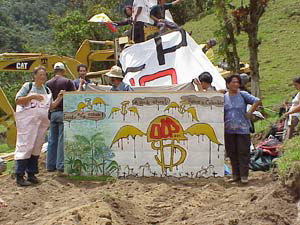 A dramatic increase in oil production will also affect the communities who live alongside the country's principle oil refineries in the coastal province of Esmeraldas. These communities, the majority of which are Afro-Ecuadorian, have some of the highest rates of cancers, respiratory, skin, and stomach ailments in all of Ecuador as a result of constant air, water, and soil contamination from the adjacent refineries.
A dramatic increase in oil production will also affect the communities who live alongside the country's principle oil refineries in the coastal province of Esmeraldas. These communities, the majority of which are Afro-Ecuadorian, have some of the highest rates of cancers, respiratory, skin, and stomach ailments in all of Ecuador as a result of constant air, water, and soil contamination from the adjacent refineries.
Communities across Ecuador have launched innovative actions to halt the OCP. In January 2002, residents of the Mindo Cloudforest staged a peaceful tree-sit on a remote ridge top to prevent pipeline construction through the area. After two-months, the Mindo campaigners were brutally evicted from their tree-sit. In November 2002 they reoccupied the site - now their own recently purchased private property - only to again be evicted and arrested by security forces.
More on what you can do can be found on the Rainforest Information Centre website. Also watch the video Amazon Oil Pipeline:Pollution, Corruption & Poverty (VHS and VCD, available from
Rainforest Information Centre) and arrange showings to your friends and local community.
Oil is now flowing through the pipeline.
Ecuadorian Government adopts 'new' oil policy to expand drilling in the Amazon, Indymedia UK, 5 August 2003
Robert Goodland, Ecuador: Oleoducto de Crudos Pesados (OCP) (Heavy Crude Oil Pipeline): Independent Compliance Assessment of OCP with the World Bank’s Environmental and Social Policies, 9 September 2002
Keith Parkins, Pipeline Politics, Indymedia UK, 21 August 2003
Keith Parkins, Brittle Power, September 2003
Amazon Oil Pipeline:Pollution, Corruption & Poverty, Rainforest Information Centre, 2002 {video}
Project Profile: The OCP Pipeline, Amazon, January 2003